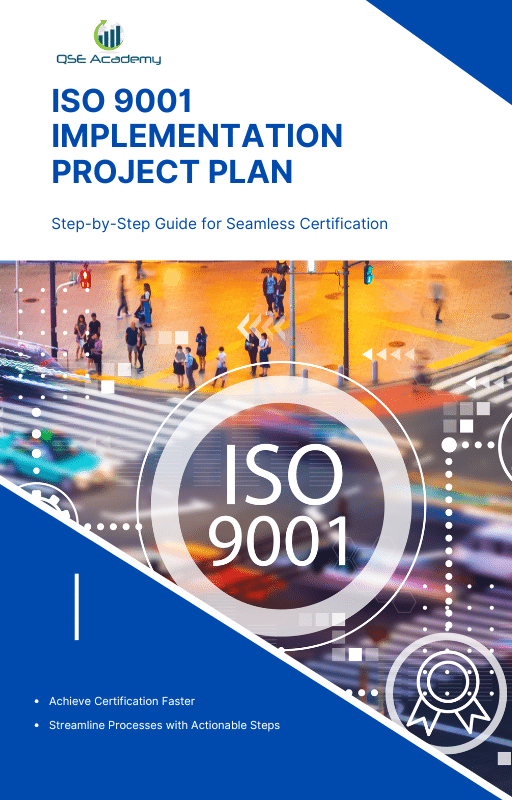Interested Parties ISO 9001 : How to Define and Manage them
Interested Parties ISO 9001: How to Define and Manage Them
Have you ever stopped to think about all the different people or groups that influence your business? From customers and employees to suppliers and even regulators, these key players—known as Interested Parties ISO 9001—are critical to your organization’s success. But here’s the thing: understanding and managing their needs isn’t just a good business practice; it’s a requirement if you’re aiming for ISO 9001 certification.
In this article, we’ll explore what Interested Parties ISO 9001 means, why they’re so important to your quality management system (QMS), and how you can identify and address their needs effectively. By the end, you’ll have a clearer picture of how managing these relationships can strengthen your business and keep you on the path to ISO 9001 compliance. Ready to dive in? Let’s go!
What Are Interested Parties in ISO 9001?
Let’s start by breaking down the concept of Interested Parties ISO 9001. In simple terms, these are the people, groups, or organizations that either impact your business or are impacted by it. Think of them as your “circle of influence” within your quality management system (QMS). But don’t worry—it’s not as overwhelming as it sounds!
ISO 9001 requires you to identify these parties because their needs and expectations play a huge role in shaping your processes and outcomes. If you can figure out who they are and what they need, you’ll have a better chance of maintaining compliance, improving quality, and building stronger relationships.
Definition of Interested Parties ISO 9001
An interested party, according to ISO 9001, is any individual or group that has an interest in your organization’s performance or decision-making. These parties can either influence your ability to meet your goals or be affected by your activities. The standard emphasizes the importance of understanding and addressing their expectations to ensure your QMS aligns with their needs.
Examples of Interested Parties ISO 9001
So, who exactly qualifies as an interested party? Here are some examples to give you a clearer picture:
- Customers: Probably the most obvious and important group. Meeting (and exceeding) customer expectations is central to ISO 9001.
- Employees: Your team plays a vital role in delivering quality, so understanding their needs is key.
- Suppliers: Reliable suppliers are essential for consistent quality.
- Regulators: Compliance with laws and regulations is non-negotiable.
- Shareholders or Investors: They have a vested interest in your company’s success.
- Local Communities: In some cases, the community around your business may be an interested party, especially if your operations have a direct impact on them (e.g., environmental concerns).
Example:
Imagine you run a small manufacturing company. Your Interested Parties ISO 9001 might include customers who expect high-quality products, employees who need clear safety protocols, and local authorities who require compliance with environmental regulations. Identifying these groups helps you tailor your processes to meet everyone’s needs.
Why Knowing Your Interested Parties Matters
Understanding who your interested parties are and what they expect isn’t just an exercise in compliance—it’s a smart business strategy. When you know what drives your stakeholders, you can create processes that not only meet ISO 9001 standards but also foster trust, satisfaction, and long-term success.
In the next section, we’ll dive into why interested parties are critical to ISO 9001 compliance and how they fit into the bigger picture of your QMS. Let’s keep going!
Why Interested Parties Are Critical to ISO 9001 Compliance
If you’re wondering why ISO 9001 places so much emphasis on understanding and managing interested parties, the answer is simple: they’re essential to your success. Whether it’s your customers, employees, or suppliers, your business thrives—or struggles—based on how well you meet their needs. Addressing the expectations of Interested Parties ISO 9001 isn’t just about ticking boxes for certification; it’s about creating a foundation for sustainable growth and strong relationships.
Let’s break it down further and explore why managing interested parties is such a big deal for ISO 9001 compliance and your business as a whole.
The Role of Interested Parties in Your Quality Management System
ISO 9001 is all about building a quality management system (QMS) that delivers value and consistency. And who defines what “quality” means in your business? That’s right—your interested parties. Their expectations set the standard for what you need to achieve.
Why This Matters:
- Guides Your Goals: Understanding the needs of Interested Parties ISO 9001 helps you set meaningful quality objectives.
- Drives Your Processes: Your QMS is built around meeting the requirements of interested parties, so identifying them is step one.
- Supports Compliance: Regulators and industry standards often fall into the “interested parties” category, so addressing their needs keeps you on the right side of the law.
Example:
A healthcare provider’s QMS might focus on patient safety, driven by the expectations of patients, regulators, and insurance companies. By addressing these parties’ needs, the provider can meet ISO 9001 requirements while improving care quality.
Benefits of Identifying Interested Parties ISO 9001
Taking the time to identify and understand your interested parties brings a range of benefits that go far beyond compliance. Here’s what you stand to gain:
- Improved Stakeholder Trust:
When you demonstrate that you’re listening to and addressing the needs of your stakeholders, you build trust and credibility.Example: A logistics company that consistently delivers on-time shipments builds trust with customers, leading to repeat business and referrals. - Enhanced Customer Satisfaction:
Customers are at the heart of any QMS. By understanding their expectations and aligning your processes to meet them, you can boost satisfaction and loyalty.Example: An e-commerce business might prioritize fast delivery times because their customers value speed and convenience. - Stronger Supplier Relationships:
By including suppliers as Interested Parties ISO 9001, you can create partnerships based on mutual benefit, ensuring consistent quality in your supply chain.Example: A food manufacturer working closely with farmers to meet quality standards benefits both parties and ensures compliance. - Business Growth:
When your QMS aligns with the needs of all interested parties, you’re better positioned to grow sustainably. Whether it’s attracting new customers, securing investment, or meeting regulatory requirements, managing interested parties gives you a competitive edge.
Connecting the Dots
The expectations of Interested Parties ISO 9001 are like the blueprint for your QMS. By identifying these stakeholders, understanding their needs, and addressing them effectively, you’re not just meeting ISO 9001 requirements—you’re creating a business that thrives on trust, satisfaction, and efficiency.
In the next section, we’ll dive into practical steps to define your interested parties and manage their needs effectively. Stay with me—we’re getting into the “how” next!
How to Define Interested Parties for Your Organization
By now, you know how important Interested Parties ISO 9001 are to your quality management system (QMS). But how exactly do you figure out who these parties are and what they need? Don’t worry—it’s not as complicated as it sounds. In this section, we’ll walk through practical steps to define your interested parties and make sure you’re addressing their expectations effectively.
Step 1: Identify Who Your Interested Parties Are
The first step is mapping out everyone who has an impact on your organization—or is impacted by it. Think beyond just customers and employees. ISO 9001 encourages you to take a broad look at both internal and external parties.
How to Identify Them:
- Internal Parties: These are people within your organization, such as employees, management, and shareholders.
- External Parties: These could include customers, suppliers, regulators, investors, and even the local community.
Example:
A construction company might identify internal parties like project managers and workers, while external parties could include clients, local government bodies, and subcontractors.
Step 2: Understand Their Needs and Expectations
Once you’ve identified your interested parties, the next step is figuring out what they care about. Each group will have different expectations, so it’s essential to gather insights that help you address their needs effectively.
Ways to Gather Insights:
- Customer Surveys: Ask customers what matters most to them—quality, delivery time, pricing, etc.
- Employee Feedback: Hold team meetings or anonymous surveys to understand your employees’ concerns.
- Supplier Discussions: Collaborate with suppliers to ensure mutual expectations are clear.
- Regulatory Research: Stay up-to-date with industry regulations and compliance requirements.
Example:
A healthcare clinic might find that patients prioritize short wait times, while regulators focus on data privacy and safety protocols.
Step 3: Prioritize the Most Relevant Parties
Not all interested parties will have the same level of influence on your business. Once you’ve identified them, prioritize the ones whose needs are most critical to your QMS and overall success.
Questions to Consider:
- Which parties have the biggest impact on your ability to meet ISO 9001 requirements?
- Are there any parties whose expectations conflict with each other? If so, how can you balance them?
- What risks or opportunities come from addressing—or not addressing—certain needs?
Example:
A tech startup might prioritize customers and investors above other parties, focusing on delivering innovative solutions while maintaining financial backing.
Step 4: Document Your Findings
ISO 9001 requires you to document information about your interested parties. This ensures their needs and expectations are clearly defined and incorporated into your QMS.
What to Document:
- A list of interested parties (internal and external).
- Their needs, expectations, and any applicable requirements (e.g., legal or contractual).
- How their needs impact your processes and quality objectives.
Example:
A retail business might document that customers expect fast delivery, employees value training opportunities, and suppliers need clear payment terms.
Step 5: Review and Update Regularly
Just like your business evolves, so do the needs of your interested parties. Regularly reviewing and updating this information ensures your QMS stays aligned with their expectations.
When to Review:
- After significant changes, like launching a new product or expanding to a new market.
- During regular QMS reviews or internal audits.
Example:
A restaurant might update its documentation after introducing online ordering, which brings new interested parties like delivery partners and technology vendors.
Why This Process Matters
Defining your Interested Parties ISO 9001 is the foundation for creating a QMS that works for everyone involved. By identifying who they are, understanding their needs, and prioritizing their expectations, you set your business up for long-term success.
In the next section, we’ll look at how to effectively manage your interested parties and maintain strong relationships with them. Let’s keep building on this foundation!
Managing Interested Parties ISO 9001 Requirements
Now that you’ve defined your Interested Parties ISO 9001, the next step is figuring out how to manage them effectively. It’s not just about identifying who they are and what they want—it’s about maintaining ongoing communication, monitoring their needs, and ensuring your quality management system (QMS) evolves to meet their expectations. Let’s explore some practical ways to manage your interested parties and stay on top of ISO 9001 requirements.
1. Communicate Effectively with Interested Parties
Strong communication is the foundation of managing your Interested Parties ISO 9001. Whether it’s keeping customers informed, collaborating with suppliers, or engaging with employees, open and regular communication builds trust and ensures alignment.
How to Communicate:
- Customers: Use surveys, newsletters, and social media to keep them informed and gather feedback.
- Employees: Hold regular team meetings and provide clear channels for suggestions or concerns.
- Suppliers: Establish clear agreements and maintain consistent updates on expectations and requirements.
Example:
A clothing retailer might send regular updates to suppliers about upcoming seasonal trends, ensuring they’re prepared to meet demand.
2. Monitor and Address Their Needs
The expectations of your interested parties aren’t static—they can change over time due to market trends, regulations, or internal developments. Regularly reviewing and addressing these changes ensures your QMS stays relevant and effective.
How to Monitor Needs:
- Conduct periodic reviews of feedback from customers and employees.
- Track regulatory updates to ensure compliance with legal requirements.
- Stay informed about industry trends and how they might affect your stakeholders.
Example:
A software company might monitor customer feedback after launching a new product to identify areas for improvement, such as bug fixes or additional features.
3. Document Interested Parties in Line with ISO 9001
To meet ISO 9001 requirements, it’s essential to document information about your interested parties, their needs, and how you’re addressing them. Proper documentation ensures clarity and helps you demonstrate compliance during audits.
What to Include in Your Documentation:
- A list of your identified interested parties.
- Their needs, expectations, and any applicable requirements.
- Steps you’re taking to meet those needs.
- How you’re monitoring and updating this information.
Example:
A food manufacturer might document that customers expect high-quality ingredients, while regulators require compliance with health and safety standards. They would also outline the processes in place to meet these expectations.
4. Build Relationships That Add Value
Managing Interested Parties ISO 9001 isn’t just about meeting their expectations—it’s about building strong, mutually beneficial relationships. When stakeholders feel valued, they’re more likely to support your business and contribute to its success.
Tips for Building Relationships:
- Show appreciation for customers and employees through loyalty programs or recognition initiatives.
- Collaborate with suppliers to improve processes and reduce costs.
- Engage with local communities by supporting initiatives or addressing their concerns.
Example:
A logistics company might work closely with its drivers (internal parties) to ensure fair pay and safe working conditions, leading to better retention and stronger service quality.
5. Regularly Review and Adjust Your Approach
As your business grows and evolves, so will the needs of your interested parties. Regularly reviewing your approach and making necessary adjustments is crucial to maintaining strong relationships and meeting ISO 9001 requirements.
How to Stay Agile:
- Schedule annual reviews of your documentation and stakeholder engagement strategies.
- Use internal audits to assess how well you’re addressing the needs of interested parties.
- Encourage feedback from all stakeholders to identify areas for improvement.
Example:
An energy company might review its approach to environmental concerns after introducing new technology, ensuring it aligns with community and regulatory expectations.
Why Managing Interested Parties Matters
Effective management of Interested Parties ISO 9001 is key to creating a QMS that works for everyone involved. By maintaining clear communication, staying proactive about their needs, and documenting your efforts, you’ll not only meet ISO 9001 requirements but also foster stronger relationships that drive your business forward.
In the next section, we’ll explore common mistakes to avoid when managing interested parties, so you can stay ahead of the curve and avoid unnecessary setbacks. Let’s keep the momentum going!
Common Mistakes to Avoid When Managing Interested Parties ISO 9001
Managing Interested Parties ISO 9001 effectively can feel like walking a fine line—there are so many moving parts, and it’s easy to overlook a detail here or there. The good news? With a little awareness, you can sidestep the most common pitfalls and keep your quality management system (QMS) running smoothly. Let’s dive into some frequent mistakes and how you can avoid them.
1. Ignoring Less Obvious Interested Parties
When defining Interested Parties ISO 9001, it’s tempting to focus only on the most visible groups, like customers or employees. But what about those less obvious parties, such as local communities, regulatory bodies, or minority stakeholders? Overlooking these groups can lead to gaps in your QMS and missed opportunities to build stronger relationships.
Why It’s a Problem:
- Neglecting certain stakeholders can create blind spots in your processes.
- Over time, ignored parties may raise concerns that disrupt operations or compliance.
How to Avoid It:
- Take a broad approach when identifying interested parties. Think about anyone who might be impacted by your business or has an interest in your success.
- Revisit your list regularly to ensure no one is being overlooked.
Example:
A construction company might initially focus on clients and contractors but later realize that local communities are also key interested parties due to noise and traffic concerns from their projects.
2. Failing to Update Information
One of the most common mistakes businesses make is treating the needs of Interested Parties ISO 9001 as static. But here’s the thing: people’s expectations change, regulations evolve, and new challenges emerge. If you’re not keeping your information up to date, you could be missing critical developments.
Why It’s a Problem:
- Outdated documentation can lead to non-compliance during audits.
- You might miss opportunities to address new needs or strengthen relationships.
How to Avoid It:
- Schedule regular reviews (e.g., annually) of your interested parties and their expectations.
- Set reminders to update your documentation after significant changes, like launching a new product or entering a new market.
Example:
A tech company might initially document that customers value affordability but later update this to include data privacy concerns as regulations tighten.
3. Overcomplicating the Process
Let’s be honest: managing Interested Parties ISO 9001 can feel overwhelming, especially if you try to create overly complex systems. The more complicated the process, the harder it will be to keep everything running smoothly—and the less likely your team will stick to it.
Why It’s a Problem:
- Complex processes waste time and resources.
- Employees may feel discouraged or confused, leading to inconsistent results.
How to Avoid It:
- Keep it simple. Focus on the essentials: who your interested parties are, what they need, and how you’re addressing those needs.
- Use tools like templates or checklists to streamline the process.
Example:
Instead of drafting lengthy documents for every stakeholder, a small business might create a one-page summary outlining the top needs of its key interested parties and how they’re being addressed.
4. Neglecting Employee Input
Your employees are on the front lines—they interact with customers, use your processes, and face challenges firsthand. If you’re not including their input when managing Interested Parties ISO 9001, you’re missing out on valuable insights.
Why It’s a Problem:
- You might create processes that look good on paper but don’t work in practice.
- Employees may feel disengaged, which can impact their commitment to the QMS.
How to Avoid It:
- Involve employees in brainstorming sessions and reviews of stakeholder needs.
- Encourage open communication so employees feel comfortable sharing feedback.
Example:
A retail chain might ask store employees for input on customer expectations, gaining insights that could improve service quality and satisfaction.
5. Focusing Only on the Present
It’s easy to get caught up in the day-to-day when managing your QMS, but ISO 9001 encourages a forward-thinking approach. Ignoring future trends or risks can leave you unprepared for what’s ahead.
Why It’s a Problem:
- You risk falling behind competitors who are better prepared for industry changes.
- Long-term sustainability may be compromised.
How to Avoid It:
- Consider future trends when evaluating stakeholder needs. For example, how will technology, regulations, or market shifts affect them?
- Use risk assessments to identify potential challenges and opportunities.
Example:
An automotive manufacturer might document current supplier needs but also consider future requirements for sustainable materials as the industry moves toward greener solutions.
Why Avoiding These Mistakes Matters
Avoiding these common pitfalls will help you manage your Interested Parties ISO 9001 more effectively, keeping your QMS compliant, efficient, and forward-thinking. By identifying all relevant stakeholders, updating your information regularly, and simplifying your processes, you’ll build stronger relationships and a more resilient business.
In the next section, we’ll explore real-life success stories of companies that excelled in managing their interested parties. These examples will show you what’s possible when you get it right. Let’s keep moving!
Real-Life Examples of Managing Interested Parties ISO 9001 Effectively
Sometimes, the best way to understand how to manage Interested Parties ISO 9001 is by looking at real-world success stories. These examples show how businesses of all sizes and industries have identified, managed, and met the needs of their interested parties, leading to stronger relationships, improved processes, and successful ISO 9001 compliance.
1. The Customer-Focused Retailer
A small retail chain wanted to improve customer satisfaction and loyalty. By identifying customers as a key group of Interested Parties ISO 9001, they prioritized understanding their needs and expectations. Through surveys and feedback forms, they discovered that their customers valued faster checkout times and clearer return policies.
What They Did:
- Streamlined the checkout process by adding self-service kiosks.
- Documented a clear, customer-friendly return policy and trained staff on it.
The Result:
Customer satisfaction scores increased by 25%, and the store saw a boost in repeat business. Meeting this critical interested party’s needs also made their ISO 9001 audits smoother.
2. The Manufacturing Company and Its Suppliers
A mid-sized manufacturing company realized that their suppliers were critical Interested Parties ISO 9001. To ensure consistent product quality, they worked closely with suppliers to define clear expectations for raw materials and delivery schedules.
What They Did:
- Created detailed supplier agreements outlining quality and delivery standards.
- Held quarterly meetings with suppliers to discuss performance and address challenges.
The Result:
By fostering strong relationships with suppliers, the company reduced production delays by 40% and improved the quality of their final products, helping them maintain ISO 9001 certification.
3. The Healthcare Provider Listening to Patients
A healthcare provider identified patients as their top Interested Parties ISO 9001 and made it their mission to exceed patient expectations. After gathering feedback, they learned that patients wanted shorter wait times and clearer communication about treatment options.
What They Did:
- Implemented an online booking system to reduce wait times.
- Trained staff on patient communication skills and created brochures explaining treatment options.
The Result:
Patient satisfaction improved significantly, with more positive reviews and referrals. These changes not only supported ISO 9001 compliance but also enhanced the provider’s reputation in the community.
4. The Tech Company Adapting to Industry Trends
A tech startup focused on software development identified regulators and industry trends as key Interested Parties ISO 9001. They realized that keeping up with data privacy regulations and cybersecurity standards was crucial to their success.
What They Did:
- Assigned a dedicated compliance officer to monitor regulatory updates.
- Documented a data privacy policy and implemented regular employee training on cybersecurity best practices.
The Result:
The company not only achieved ISO 9001 certification but also gained a competitive edge by reassuring customers that their data was safe, resulting in increased trust and sales.
5. The Community-Conscious Construction Company
A construction company recognized that local communities were an often-overlooked group of Interested Parties ISO 9001. With projects that often caused noise and traffic disruptions, they decided to take proactive steps to address community concerns.
What They Did:
- Held town hall meetings to gather feedback from residents.
- Documented and implemented noise-reduction measures and traffic management plans.
The Result:
The company avoided complaints, gained community support, and built a positive reputation, all while ensuring ISO 9001 compliance.
What These Success Stories Teach Us
These examples highlight how managing Interested Parties ISO 9001 effectively can drive real results for your business. Whether it’s improving customer satisfaction, strengthening supplier relationships, or addressing regulatory requirements, the key is to identify the needs of your stakeholders and take meaningful action.
In the final section, we’ll wrap things up and discuss why managing interested parties is a cornerstone of ISO 9001 success. Let’s bring everything together!
Conclusion: Why Managing Interested Parties ISO 9001 Is Essential
By now, it should be clear that managing Interested Parties ISO 9001 isn’t just a requirement for certification—it’s a smart strategy for building a stronger, more successful business. Whether you’re a small startup or a global corporation, understanding and addressing the needs of your interested parties helps you create a quality management system (QMS) that works for everyone.
What Managing Interested Parties Achieves
Let’s recap some of the key benefits of getting this right:
- Improved Relationships: Meeting the needs of customers, employees, suppliers, and other stakeholders builds trust and loyalty.
- Better Compliance: Addressing the expectations of regulators and industry bodies ensures you stay on the right side of the law.
- Stronger Processes: By considering the input of all interested parties, your QMS becomes more effective and resilient.
- Long-Term Success: Happy stakeholders mean repeat business, stronger partnerships, and a reputation for quality that drives growth.
Example:
Think about a small logistics company. By managing their Interested Parties ISO 9001, like customers expecting on-time deliveries and employees valuing fair working conditions, they create a system that not only meets ISO standards but also strengthens their entire operation.
How to Start Managing Interested Parties
If you’re ready to take the first step, here’s a quick roadmap:
- Identify Your Interested Parties: Take the time to think about everyone who impacts—or is impacted by—your business.
- Understand Their Needs: Use surveys, feedback, and open communication to learn what matters most to them.
- Document Everything: Keep a record of your interested parties, their expectations, and how you’re addressing them to meet ISO 9001 requirements.
- Review and Improve: Regularly revisit your processes to ensure you’re staying aligned with the evolving needs of your stakeholders.
Why It’s Worth the Effort
Managing Interested Parties ISO 9001 may feel like a lot of work at first, but the rewards are worth it. When you take the time to understand and address the needs of your stakeholders, you create a business that’s not just ISO 9001 compliant—it’s stronger, more efficient, and built to last.
So, where do you go from here? Start small. Define your interested parties, document their needs, and create a plan to address them. With each step, you’ll not only meet ISO 9001 standards but also build a business that’s better equipped to thrive in a competitive world. You’ve got this!
Looking for More Resources on ISO 9001?
Looking for ISO 9001 Resources Tailored to Your Industry?
If this article helped clarify ISO 9001, take the next step with our industry-focused tools designed to simplify your certification journey:
- ISO 9001 Documentation Kits by Industry: Whether you’re in manufacturing, construction, consulting, or healthcare — we have complete, ready-to-use documentation tailored for your sector.
- Online ISO 9001 Training: Learn how to implement ISO 9001 effectively with our easy-to-follow video lessons, real-world examples, and practical exercises.
- ISO 9001 Checklist: Download our step-by-step checklist to ensure your QMS meets all the 9001:2015 requirements from start to finish.
These resources are crafted to save you time, reduce stress, and help you achieve certification with confidence. Choose your industry and start now!

👋 Hi, I’m HAFSA, and for the past 12 years, I’ve been on a journey to
make ISO standards less intimidating and more approachable for everyone.
Whether it’s ISO 9001, ISO 22000, or the cosmetics-focused ISO 22716,
I’ve spent my career turning complex jargon into clear, actionable steps
that businesses can actually use. I’m not here to call myself an expert—I prefer “enthusiast” because I truly love what I do.
There’s something incredibly rewarding about helping people navigate food safety and quality management systems
in a way that feels simple, practical, and even enjoyable.
When I’m not writing about standards, you’ll probably find me playing Piano 🎹, connecting with people, or diving into my next big project💫.
I’m an engineer specialized in the food and agricultural industry
I have a Master’s in QHSE management and over 12 years of experience as a Quality Manager
I’ve helped more than 15 companies implement ISO 9001, ISO 22000, ISO 22716, GMP, and other standards
My clients include food producers, cosmetics manufacturers, laboratories, and service companies
I believe quality systems should be simple, useful, and efficient
Outside of work, I play piano and love learning something new every day
Let’s make ISO less about stress and more about success! 🙏

















